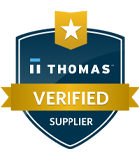Ink Types and Supply
Sprinter Marking supplies mostly alcohol based, quick drying pigmented inks in a range of colors. Pigments make up about 50% of the volume. Pigments are denser than the alcohol and will settle out typically over a few days. This pigment settling is easily visible in all color grades except black is more difficult to discern (the carbon black pigment still will settle out). Pigments can be be put back into suspension and equal dispersion with a short vigorous shaking.
Pigments are ground to a very fine particle size which provides a uniform film of deposition and consistent marking impressions. Dispersed pigments are best for uniform marking and to gain a good visible impression while allowing for quick drying action.
In some cases a non-pigmented grade of ink (water wash-off / UV fluorescing / dye type, etc) can be provided for desired marking considerations. Customers are encouraged to advise of these requirements in advance with plant personnel so marking trials can be made.
Some customers have a grade of ink that they have used successfully for their application and have asked if we have approved the ink for use with our machine. If we have not had experience with the ink grade, we will make an evaluation and offer comment. Generally we can say that thicker grades of ink they will not process well in our system. Paste type inks will not feed thru our reservoir system. Ink viscosities less than very thin paint for the most part seem to feed best with our system.
The ink bottles (1/4 or 1/2 ounce size depending upon Sprinter Model chosen) are supplied pre-filled for interchangeable / convenient usage and are disposable after depletion. The bottles are easily changed with twist off / twist on actions.
Operators should give any ink bottle being used in operation a quick shake once a day and anytime the ink bottle is replaced. The ink bottles are easily removed and replaced in the ink reservoirs by loosening the thumb screws on the reservoir.
Ink Pad Types
The white foam media pad is first supplied for both text based and symbol type marks. This media pad has very small voids that allow the finely ground pigments to flow thru for equal ink distribution each cycle. The media pads work well for the great majority of applications.
In some cases, we have found that changing to a felt based ink pad applies a greater volume of ink to each marking cycle. Some porous surfaces take more ink to provide a good legible mark. Porous rubber is an example of this surface condition. The felt pad is slightly more open and thus tends to hold a larger volume of ink. In more porous products the ink will recede into the product for a reduced visibility. Also in some cases a more pronounced image might be desired; the felt pad can assist in delivering more pigment to the mark. Felt based ink pad supply is provided upon customer comment / requests.
Ink Reservoir Types
The white foam media pad is first supplied for both text based and symbol type marks. This media pad has very small voids that allow the finely ground pigments to flow thru for equal ink distribution each cycle. The media pads work well for the great majority of applications.
In some cases, we have found that changing to a felt based ink pad applies a greater volume of ink to each marking cycle. Some porous surfaces take more ink to provide a good legible mark. Porous rubber is an example of this surface condition. The felt pad is slightly more open and thus tends to hold a larger volume of ink. In more porous products the ink will recede into the product for a reduced visibility. Also in some cases a more pronounced image might be desired; the felt pad can assist in delivering more pigment to the mark. Felt based ink pad supply is provided upon customer comment / requests.
Quick Starting Ink Reservoirs
For machines where the ink flows with gravity the operator can take the cap off a pre-filled ink bottle (shaken first) and twist the ink bottle onto the ink reservoir. After the bottle is tightened, the operator can squeeze the bottle slowly to force the ink to saturate the pad then release the bottle to vacuum off any excess ink. The ink reservoir is then ready to place in the ink pad holder to start machine cycling.
For machines where the ink flows against gravity the inverted reservoir is required. The first operation is to thread a felt wick thru the ink reservoir hole and make sure the ink wick is positioned in the groove in the reservoir so as to allow contact against the ink pad.Then a new pre-filled ink bottle is (shaken first) opened to allow the wick to be lowered into the ink bottle. After the bottle is tightened on the reservoir it can be squeezed to force the ink up into the pad; release the ink bottle and the excess ink is vacuumed off. The reservoir is now ready to insert into the ink pad holder for cycling operation.
The benefits for using Sprinter inks in small disposable bottles
Sprinter inks are commonly used with Sprinter machines for their quick drying capability and good adhesion to a wide variety of surfaces.
Sprinter pigmented inks typically contain about half by volume pigment and half solvent. When the pigment is uniformly mixed with the solvent the low viscosity fluid flows easily thru the system. It travels from the ink bottle thru the ink reservoir into the ink pad. The marking head then picks up the ink on the pad and transfers it to the surface to be marked.
Sprinter inks in different colors are offered in small bottles (1/4 and 1/2 ounce depending upon Sprinter machine model) that allow for easy replacement when depleted. Operators simply twist off the depleted bottle and after a vigorous shake of the new ink supply bottle twist it onto the ink reservoir.
At our plant, before any ink is transferred from a master batch to the small 1/4 and 1/2 ounce bottles the ink is vigoursly mixed to insure a homogeneous mixture of pigment and solvent ratio is maintained. Then the small ink supply bottles are capped with a fixed torque twist for proper sealing. Finally each bottle is then labeled and a stretch wrap is applied and heat sealed to lock cap to bottle.
Each bottle is noted on the label that it should be shaken well before placing in operation. Written instructions supplied with each machine advise that ink supply bottles used in the operation should be shaken daily in use for proper pigment dispersion in the solution.
Since each bottle of ink typically provides for thousands or tens of thousands of impressions depending upon message size, most operators find these bottles provide days of production time.
If the operator fails to shake the ink with the frequency suggested the pigment can settle in the bottle. As the ink bottle is placed in operation either the pigment or the solvent (depending upon bottle orientation) will come thru first. If the pigment comes first it will be slow to feed and tend to clog the pad; if the solvent comes thru first the image will be faint.
Occasionally, we have customers that purchase our ink in larger containers. The problems we have seen and cautioned against here are failure to maintain a homogeneous mixture when transferring ink to the ink supply bottles. Additionally larger bottles tend to be much more ink than is needed so the ink bottles set for extended periods; pigment will tend to agglomerate and become difficult to disperse on mixing. It’s for this reason that the small ink supply bottles are best since each time one is replaced the proper ratio of pigment to solvent is maintained. Transferring ink from a large container to the small ink bottles can be difficult to control and result in spilled ink / wasted ink.
Operation Additional Comments:
Assuming our ink (or a grade of ink that is compatible with our system) is used, ink bottles should always be shaken a few times vigorously before using (and once a day in use) to insure that the pigment is evenly dispersed into solution as it tends to settle out after a few days of storage.
With regards to marking heads that use felt tips (dot marking heads for example), we recommend that the tips of the marking head (the felt tips) be first loaded with ink using the Yorker style ink bottle supplied. Ink can be transferred to the felt tip by squeezing the ink bottle with the Yorker tip touching the felt tip. (Instructions are including on this procedure with each machine). These felt tips should be replaced with some frequency (1 to 3 days is common depending upon usage as the pigment can build up in the tip).
The above procedures should allow the customer to utilize the Sprinter model to apply useful code marks.
If the ink bottle is not secure to the reservoir or the ink bottle has a pinhole leak, ink will leak from the ink pad. To remedy either tighten the bottle securely or replace with a new bottle.


